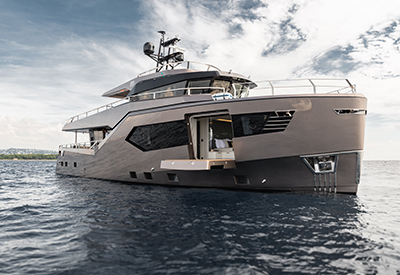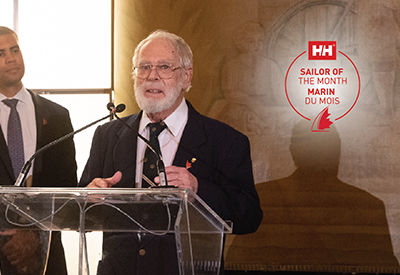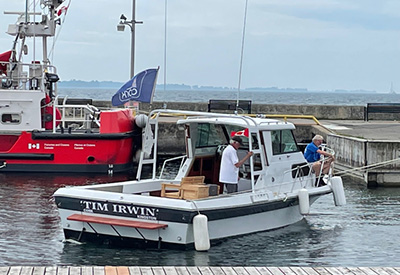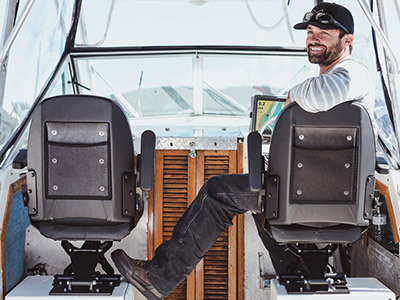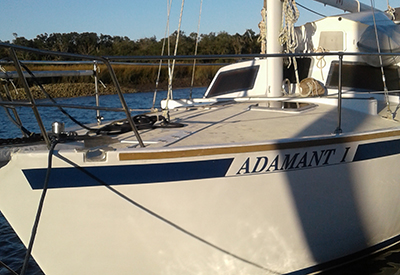Building Adamant 1 – Part B, December 21
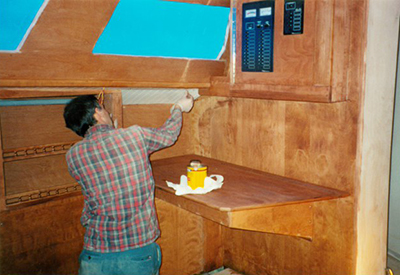
December 20, 2017
Living the dream! Longtime CY staffer and now blogger Lynn Lortie with her husband Pat left Midland more than a year ago to make their way into the Great Loop and head out on a three year sailing odyssey. Follow their progress right here in CYOB.
Last issue, Lynn’s blog began the story of how the cruisers designed and began to build Adamant 1. This time, we launch their dreamboat. A special note: as you read this account it’s worth remembering that, perhaps like you, neither Lynn nor Pat had any background in yacht design or construction. Here is how Lynn explained Pat’s ascent from enthusiast to designer:
“Pat was a produce manager at the local IGA for 35 years. He went to college for Sales and Salesmanship! He was not trained. He had a book that was printed in the 30’s for the info on how to calculate the displacement weight and the lofting. He read Steve Killing’s design book too. Then he worked it out longhand using the Simpson formula. He also had the Gougeon Brothers book for the epoxy part. Self taught! “
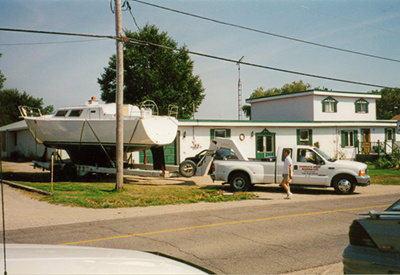 We had epoxied the inside deck seam while the boat was upside down, so now we were able to do the inside hull seam. Next to install were the bulkheads, working from the bow. We installed framework in the hull of the boat and those frames became the baffles for the water and fuel tanks, which were to be below the cabin sole. We ran all the plumbing and wiring while the hull was open, and then cut the hole in the hull for access to the keel. We had purchased an old keel, which we cut into chunks; collected loads of old tire weights and picked up slugs from a printing company that was shutting down. We dumped all this into the keel, filled the open spaces with powdered cement then put the water to it. Once everything was dry and hard, we sealed the keel with wood and epoxy, built two steel motor mounts and lowered a 39 HP Yanmar 3JH engine into the hole. More wiring, more plumbing, more through-hulls and we were able to put the floor on.
We had epoxied the inside deck seam while the boat was upside down, so now we were able to do the inside hull seam. Next to install were the bulkheads, working from the bow. We installed framework in the hull of the boat and those frames became the baffles for the water and fuel tanks, which were to be below the cabin sole. We ran all the plumbing and wiring while the hull was open, and then cut the hole in the hull for access to the keel. We had purchased an old keel, which we cut into chunks; collected loads of old tire weights and picked up slugs from a printing company that was shutting down. We dumped all this into the keel, filled the open spaces with powdered cement then put the water to it. Once everything was dry and hard, we sealed the keel with wood and epoxy, built two steel motor mounts and lowered a 39 HP Yanmar 3JH engine into the hole. More wiring, more plumbing, more through-hulls and we were able to put the floor on.
It was getting on to winter , so we built a cradle, had the crane come back, filled in the trench and set the boat into the cradle. Now we needed steps to get in and out of the boat. We covered the boat completely, built some stairs and put a door at the stern so we could go in and out. The boat has one inch of styrofoam insulation from the cabin roof right down to the waterline, so we were able to run small heaters in the boat all winter. During the winter we finished the interior, installed lights, built cabinets and settees, installed the pedestal, the cockpit seats, the steering and the plumbing fixtures. Once spring came, we removed the tarps and set about painting the exterior.
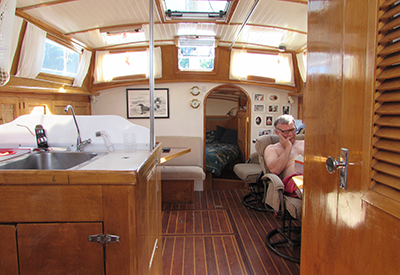 On August 12, 2001, exactly 23 months from the day we cut our first piece of wood, Adamant 1 was launched. In attendance were family, friends, people we never met before and the press! The marina manager was terrified his equipment would breakdown and spoil the show! The next day we loaded fuel aboard and went for our first test run. Fantastic! We put aboard our safety gear, stocked up the fridge, grabbed some sheets and clothes and headed out to spend two well deserved weeks enjoying our new boat.
On August 12, 2001, exactly 23 months from the day we cut our first piece of wood, Adamant 1 was launched. In attendance were family, friends, people we never met before and the press! The marina manager was terrified his equipment would breakdown and spoil the show! The next day we loaded fuel aboard and went for our first test run. Fantastic! We put aboard our safety gear, stocked up the fridge, grabbed some sheets and clothes and headed out to spend two well deserved weeks enjoying our new boat.
Both of our children got married in 2002, so we didn’t get the mast, sails and rigging done until 2003. We installed the davits, solar panels and electronics and Adamant was a finished boat. She is 38′ long, weighs 18,400 pounds, and carries 220 gallons of water and 85 gallons of diesel. Because all our tanks are under the cabin sole, both cabins have full use of the space under the berths and under the settees is all storage. I have two bilge lockers, both are 3′ x 3′ x 24“ deep. There is  another locker, a little bigger, close to the companionway where the batteries and hot water tank reside. Everything can be reached by lifting the lids. The engine is amidships so oil changes are easy. I have a 6 cubic foot fridge and 3 cubic foot freezer. The galley sinks are normal kitchen size. We have all self-tailing winches and all lines run into the cockpit. With all new electronics in 2016, she has become our floating dream. Right now we have 26,000 nautical miles on her with a lot more to go.
another locker, a little bigger, close to the companionway where the batteries and hot water tank reside. Everything can be reached by lifting the lids. The engine is amidships so oil changes are easy. I have a 6 cubic foot fridge and 3 cubic foot freezer. The galley sinks are normal kitchen size. We have all self-tailing winches and all lines run into the cockpit. With all new electronics in 2016, she has become our floating dream. Right now we have 26,000 nautical miles on her with a lot more to go.
This weekend we head back to Fernandina Beach to pick her up, relaunch her and head back to the Bahamas for another winter. Until next time……

